brakes BMW X3 3.0I 2006 E83 Owner's Manual
[x] Cancel search | Manufacturer: BMW, Model Year: 2006, Model line: X3 3.0I, Model: BMW X3 3.0I 2006 E83Pages: 133, PDF Size: 8.37 MB
Page 39 of 133
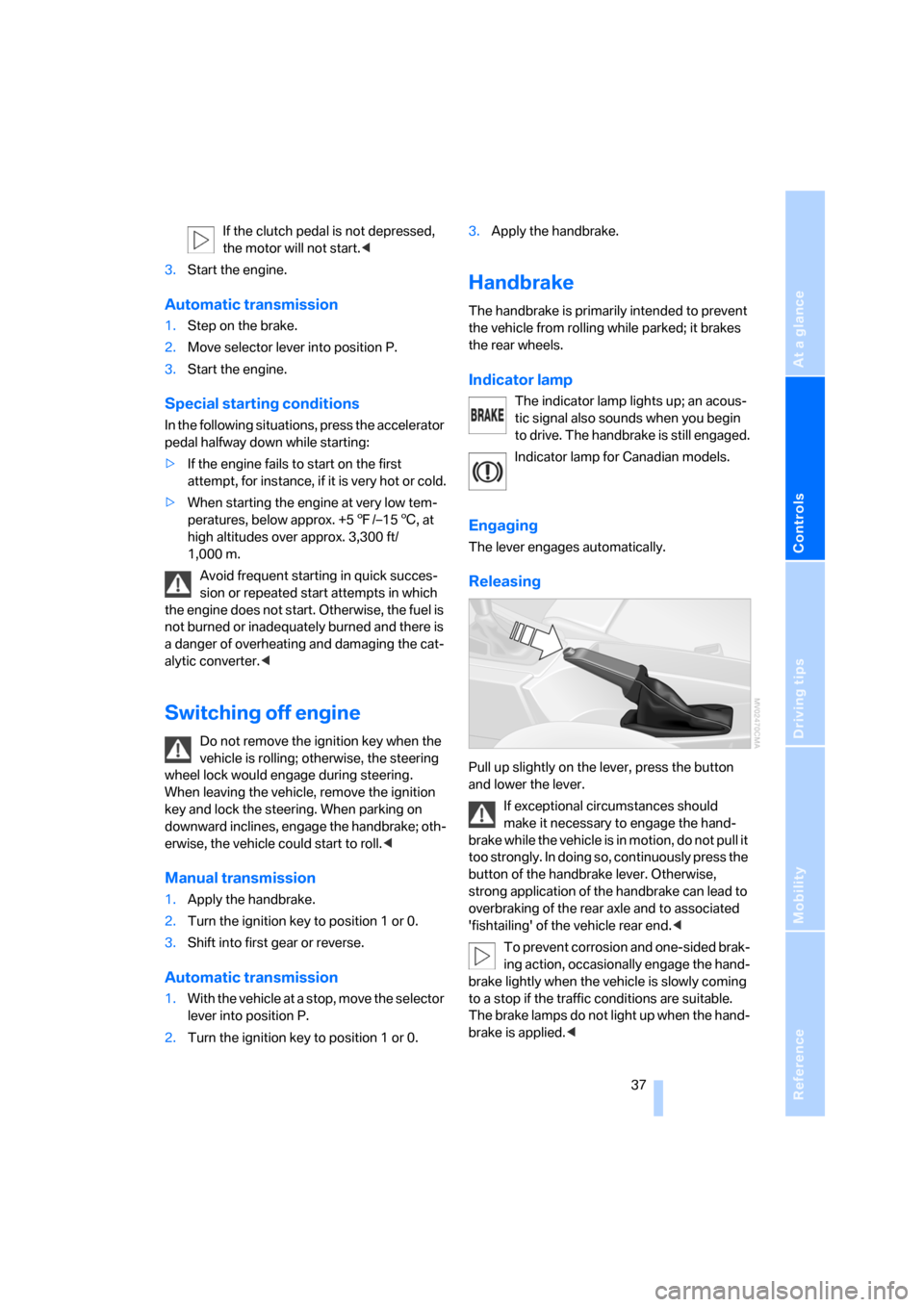
Reference
At a glance
Controls
Driving tips
Mobility
37
If the clutch pedal is not depressed,
the motor will not start.<
3.Start the engine.
Automatic transmission
1.Step on the brake.
2.Move selector lever into position P.
3.Start the engine.
Special starting conditions
In the following situations, press the accelerator
pedal halfway down while starting:
>If the engine fails to start on the first
attempt, for instance, if it is very hot or cold.
>When starting the engine at very low tem-
peratures, below approx. +57/–156, at
high altitudes over approx. 3,300 ft/
1,000 m.
Avoid frequent starting in quick succes-
sion or repeated start attempts in which
the engine does not start. Otherwise, the fuel is
not burned or inadequately burned and there is
a danger of overheating and damaging the cat-
alytic converter.<
Switching off engine
Do not remove the ignition key when the
vehicle is rolling; otherwise, the steering
wheel lock would engage during steering.
When leaving the vehicle, remove the ignition
key and lock the steering. When parking on
downward inclines, engage the handbrake; oth-
erwise, the vehicle could start to roll.<
Manual transmission
1.Apply the handbrake.
2.Turn the ignition key to position 1 or 0.
3.Shift into first gear or reverse.
Automatic transmission
1.With the vehicle at a stop, move the selector
lever into position P.
2.Turn the ignition key to position 1 or 0.3.Apply the handbrake.
Handbrake
The handbrake is primarily intended to prevent
the vehicle from rolling while parked; it brakes
the rear wheels.
Indicator lamp
The indicator lamp lights up; an acous-
tic signal also sounds when you begin
to drive. The handbrake is still engaged.
Indicator lamp for Canadian models.
Engaging
The lever engages automatically.
Releasing
Pull up slightly on the lever, press the button
and lower the lever.
If exceptional circumstances should
make it necessary to engage the hand-
brake while the vehicle is in motion, do not pull it
too strongly. In doing so, continuously press the
button of the handbrake lever. Otherwise,
strong application of the handbrake can lead to
overbraking of the rear axle and to associated
'fishtailing' of the vehicle rear end.<
To prevent corrosion and one-sided brak-
ing action, occasionally engage the hand-
brake lightly when the vehicle is slowly coming
to a stop if the traffic conditions are suitable.
The brake lamps do not light up when the hand-
brake is applied.<
Page 50 of 133

Technology for comfort, convenience and safety
48
Malfunction
The LED in the button flashes and a short con-
tinuous tone sounds. PDC is malfunctioning.
Switch off PDC. Have the system checked.
To prevent this problem, keep the sensors
clean and free of ice or snow in order to ensure
that they will continue to operate effectively.
When using high-pressure washers, do not
spray sensors for long periods and keep the
sprayer at least 4 in/10 cm away from the sen-
sors.
System limits
Even with PDC, final responsibility for
estimating the distance between the
vehicle and any obstructions always remains
with the driver. Even when sensors are involved,
there is a blind spot in which objects cannot be
detected. The system is also subject to the
physical limits that apply to all forms of ultra-
sonic measurement, such as those encoun-
tered with tow bars and trailer couplings, or thin
and wedge-shaped objects, etc. Low objects
already displayed, e.g. a curb, can come into the
blind spot of the sensors before a continuous
tone sounds. The system may fail to detect
higher obstacles such as ledges.
Loud sources of sound, inside and outside the
vehicle, could drown out the PDC signal tone.<
Driving stability control
systems
Your BMW is equipped with an extended array
of systems designed to enhance and maintain
vehicle stability even under unfavorable driving
conditions.
ABS Antilock Brake System
ABS prevents the wheels from locking during
braking. Safe steering response is maintained
even during full braking. This results in an
increase in the active safety.
ABS is operational every time you start the
engine. Safe braking, refer to page78.
Electronic brake-force distribution
The system controls the brake pressure in the
rear wheels to ensure a stable braking behavior.
DBC Dynamic Brake Control
When the brake pedal is depressed quickly, this
system automatically generates a maximum
braking force distribution and thus helps keep
the braking distance to a minimum during full
braking. This system exploits all of the benefits
provided by ABS.
As long as you want full braking to continue, do
not reduce pressure on the brake.
DSC Dynamic Stability Control
DSC prevents slip at the drive wheels when
starting off and accelerating. DSC also detects
unstable driving conditions, such as a fishtailing
of the vehicle's rear end or the sliding of the
vehicle on its front wheels. In these circum-
stances, DSC helps keep the vehicle on a safe
path, within physical limits, by reducing engine
output and by applying the brakes in individual
wheels.
The DSC is operational every time you start the
engine.
The laws of physics cannot be repealed,
even with DSC. An appropriate driving
style always remains the responsibility of the
driver. Do not reduce the additional safety mar-
gin again by taking unnecessary risks.<
Indicator lamp
The indicator lamp goes out shortly
after the engine starts.
When the indicator lamp flashes:
DSC is controlling the drive and braking forces.
When the indicator lamp stays lit:
DSC has been switched off with the button.
Page 51 of 133
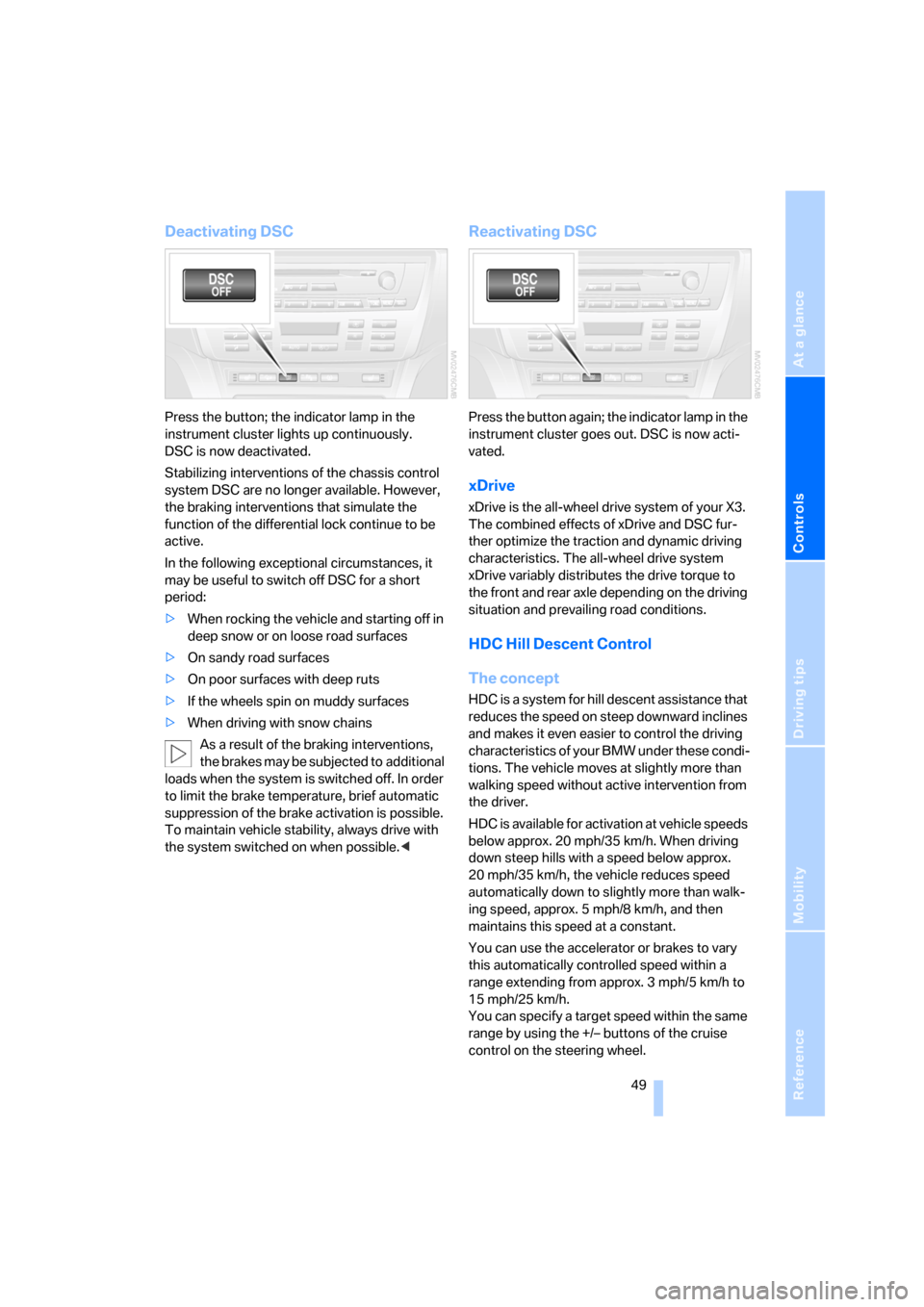
Reference
At a glance
Controls
Driving tips
Mobility
49
Deactivating DSC
Press the button; the indicator lamp in the
instrument cluster lights up continuously.
DSC is now deactivated.
Stabilizing interventions of the chassis control
system DSC are no longer available. However,
the braking interventions that simulate the
function of the differential lock continue to be
active.
In the following exceptional circumstances, it
may be useful to switch off DSC for a short
period:
>When rocking the vehicle and starting off in
deep snow or on loose road surfaces
>On sandy road surfaces
>On poor surfaces with deep ruts
>If the wheels spin on muddy surfaces
>When driving with snow chains
As a result of the braking interventions,
the brakes may be subjected to additional
loads when the system is switched off. In order
to limit the brake temperature, brief automatic
suppression of the brake activation is possible.
To maintain vehicle stability, always drive with
the system switched on when possible.<
Reactivating DSC
Press the button again; the indicator lamp in the
instrument cluster goes out. DSC is now acti-
vated.
xDrive
xDrive is the all-wheel drive system of your X3.
The combined effects of xDrive and DSC fur-
ther optimize the traction and dynamic driving
characteristics. The all-wheel drive system
xDrive variably distributes the drive torque to
the front and rear axle depending on the driving
situation and prevailing road conditions.
HDC Hill Descent Control
The concept
HDC is a system for hill descent assistance that
reduces the speed on steep downward inclines
and makes it even easier to control the driving
characteristics of your BMW under these condi-
tions. The vehicle moves at slightly more than
walking speed without active intervention from
the driver.
HDC is available for activation at vehicle speeds
below approx. 20 mph/35 km/h. When driving
down steep hills with a speed below approx.
20 mph/35 km/h, the vehicle reduces speed
automatically down to slightly more than walk-
ing speed, approx. 5 mph/8 km/h, and then
maintains this speed at a constant.
You can use the accelerator or brakes to vary
this automatically controlled speed within a
range extending from approx. 3 mph/5 km/h to
15 mph/25 km/h.
You can specify a target speed within the same
range by using the +/– buttons of the cruise
control on the steering wheel.
Page 52 of 133
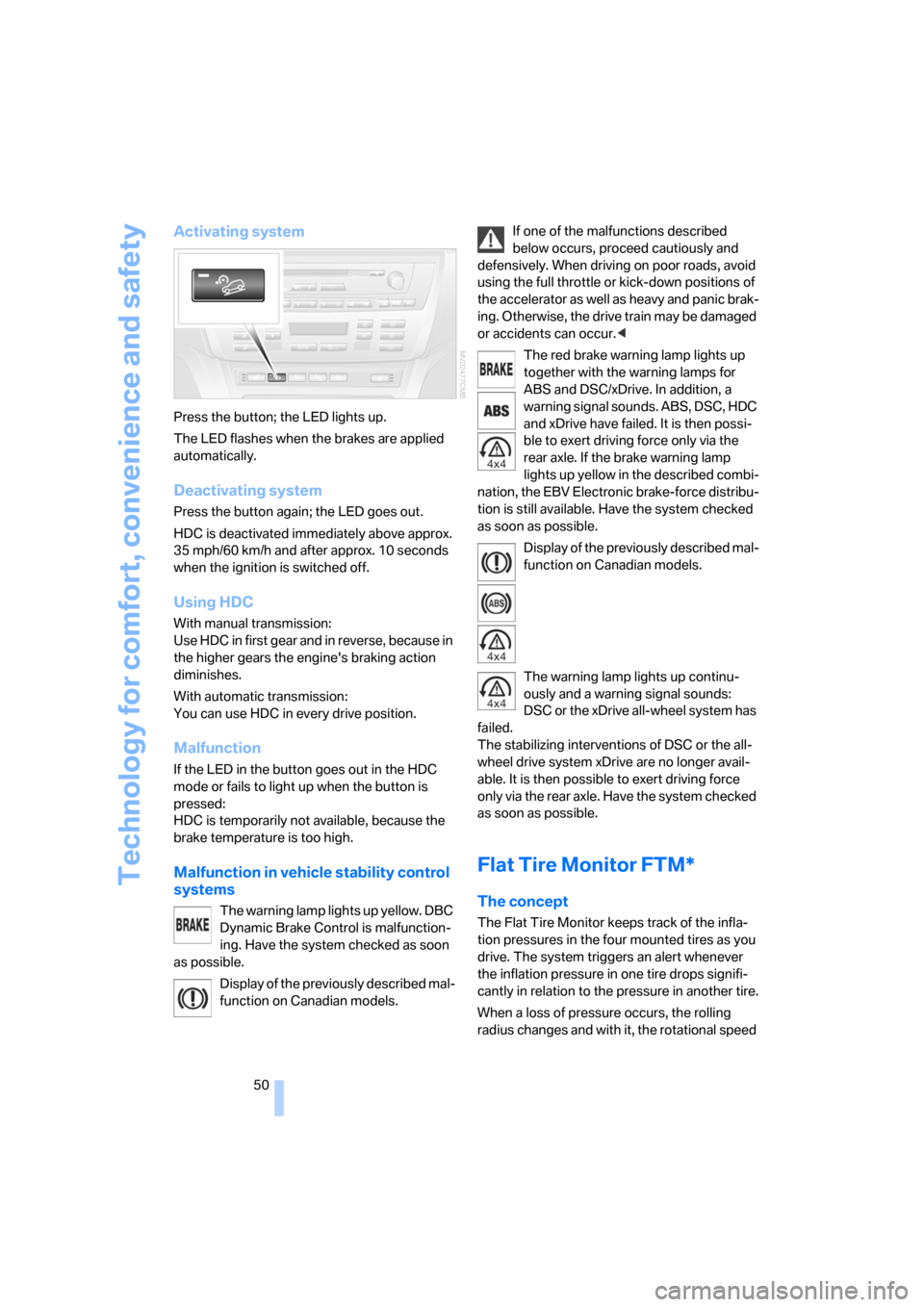
Technology for comfort, convenience and safety
50
Activating system
Press the button; the LED lights up.
The LED flashes when the brakes are applied
automatically.
Deactivating system
Press the button again; the LED goes out.
HDC is deactivated immediately above approx.
35 mph/60 km/h and after approx. 10 seconds
when the ignition is switched off.
Using HDC
With manual transmission:
Use HDC in first gear and in reverse, because in
the higher gears the engine's braking action
diminishes.
With automatic transmission:
You can use HDC in every drive position.
Malfunction
If the LED in the button goes out in the HDC
mode or fails to light up when the button is
pressed:
HDC is temporarily not available, because the
brake temperature is too high.
Malfunction in vehicle stability control
systems
The warning lamp lights up yellow. DBC
Dynamic Brake Control is malfunction-
ing. Have the system checked as soon
as possible.
Display of the previously described mal-
function on Canadian models.If one of the malfunctions described
below occurs, proceed cautiously and
defensively. When driving on poor roads, avoid
using the full throttle or kick-down positions of
the accelerator as well as heavy and panic brak-
ing. Otherwise, the drive train may be damaged
or accidents can occur.<
The red brake warning lamp lights up
together with the warning lamps for
ABS and DSC/xDrive. In addition, a
warning signal sounds. ABS, DSC, HDC
and xDrive have failed. It is then possi-
ble to exert driving force only via the
rear axle. If the brake warning lamp
lights up yellow in the described combi-
nation, the EBV Electronic brake-force distribu-
tion is still available. Have the system checked
as soon as possible.
Display of the previously described mal-
function on Canadian models.
The warning lamp lights up continu-
ously and a warning signal sounds:
DSC or the xDrive all-wheel system has
failed.
The stabilizing interventions of DSC or the all-
wheel drive system xDrive are no longer avail-
able. It is then possible to exert driving force
only via the rear axle. Have the system checked
as soon as possible.
Flat Tire Monitor FTM*
The concept
The Flat Tire Monitor keeps track of the infla-
tion pressures in the four mounted tires as you
drive. The system triggers an alert whenever
the inflation pressure in one tire drops signifi-
cantly in relation to the pressure in another tire.
When a loss of pressure occurs, the rolling
radius changes and with it, the rotational speed
Page 55 of 133

Reference
At a glance
Controls
Driving tips
Mobility
53
Have the damaged tire replaced by your BMW
Sports Activity Vehicle Center or a workshop
that is familiar with TPM and works in accor-
dance with BMW repair procedures, using
appropriately trained personnel.
Malfunction
The yellow warning lamp flashes and
then lights up continuously. Flat tires
cannot be detected.
Such a message is displayed in the following
situations:
>In the event of a malfunction:
Have the system checked
>When a wheel without TPM electronics is
mounted, e.g. a compact wheel
>When TPM is experiencing temporary inter-
ference from other systems or devices that
use the same frequency
Brake force display
The brake lamps light up in two stages,
depending on how heavily you apply the brakes.
>Normal braking:
The brake lamps 1 and the center brake
lamp light up.
>Powerful braking:
The brake lamps 1 and 2 light up together
with the center brake lamp.
Airbags
The following airbags are located beneath the
marked covers:
1Front airbags
2Head airbags
3Side airbags in front and rear
*
Protective action
To ensure that the safety systems con-
tinue to provide optimal protection,
please follow the instructions on page26.<
The front airbags help protect the driver and
front passenger by responding to frontal
impacts in which safety belts alone cannot pro-
vide adequate restraint. When needed, the
head and side airbags help provide protection in
the event of side impact. The relevant side air-
bag supports the side upper body area. The
respective head airbag supports the head.
The airbags will purposely not be activated by
every collision, e.g. not by more minor acci-
dents, or rear-end collisions.
Do not apply adhesive materials to the
cover panels of the airbags, cover them or
modify them in any other way.
Do not attempt to remove the airbag retention
system from the vehicle. Do not modify the indi-
vidual components of the system or its wiring in
any way. This includes the padded covers in the
center of the steering wheel, on the dashboard,
the doors, and the roof pillars as well as the
sides of the headliner. Do not attempt to
remove or dismantle the steering wheel.
Do not touch the individual components
directly after the system has been triggered,
because there is a danger of burns.
Page 80 of 133

Things to remember when driving
78
Safe braking
Your BMW is equipped with ABS as standard
equipment. In situations in which it is required, it
is best to apply the brakes fully. Since the vehi-
cle maintains steering responsiveness, you can
nevertheless avoid possible obstacles with a
minimum of steering effort.
Pulsation at the brake pedal combined with
sounds from the hydraulic circuits indicates to
the driver that ABS is in its active mode.
Wet roads
On wet roads or in heavy rain, briefly apply light
pressure to the brake pedal every few miles.
Watch traffic conditions to ensure that this
maneuver does not endanger other road users.
The heat that is generated by the brake applica-
tions helps to dry the brake pads and rotors.
The full braking force will then be available
when you need it.
Hills
To prevent overheating and reduced effi-
ciency of the brake system, drive long or
steep downhill grades in the gear in which the
least braking is required. Otherwise, even light
but continuous pressure on the brake can lead
to high temperatures, brake wear and possibly
even brake failure.<
The braking action of the engine can be further
intensified by downshifting, all the way down to
first gear if need be. This strategy helps you
avoid placing excessive loads on the brake sys-
tem. Downshifting in manual mode of automatic
transmission, refer to page39. When descend-
ing hills slowly, use HDC Hill Descent Control,
refer to page49.
Never drive with the clutch depressed,
with the transmission in neutral, or with
the engine switched off; otherwise, you will
have neither the braking action of the engine or
nor its power assistance to the brakes or steer-
ing.
Never allow floor mats, carpeting, or other arti-
cles to protrude into the area around the brake
or accelerator pedals and obstruct their move-
ment.<
Corrosion on brake rotors
When the vehicle is driven only occasionally,
during extended periods when the vehicle is not
used at all, and in operating conditions where
brake applications are less frequent, there is an
increased tendency for corrosion to form on
rotors, while contaminants accumulate on the
brake pads. This occurs because the minimal
pressure which must be exerted by the pads
during brake applications to clean the rotors is
not reached.
Should corrosion form on the brake rotors, the
brakes will tend to respond with a pulsating
effect that even extended application will fail to
cure.
Cargo loading
To avoid loading the tires beyond their
approved carrying capacity, never over-
load the vehicle. Overloading can lead to over-
heating and increases the rate at which damage
develops inside the tires. The ultimate result
can assume the form of a sudden blow-out.<
Determining load limit
1.Locate the following statement on your
vehicle's placard
*:
The combined weight of occupants
and cargo should never exceed
XXX lbs. or YYY kg. Otherwise, the vehicle
may be damaged and unstable driving con-
ditions may result.<
2.Determine the combined weight of the
driver and passengers that will be riding in
your vehicle.
Page 83 of 133

Reference
At a glance
Controls
Driving tips
Mobility
81
>Do not drive in water that is deeper than
20 in/50 cm. If you must drive through water
up to that depth, drive at a walking speed
and do not stop.
After leaving the water, press on the foot-
brake gently several times while driving at a
low speed. The brake applications will help
to dry the brakes, thus preventing a reduc-
tion in braking performance caused by the
moisture.
For cleaning the handbrake, apply the lever
slightly at approx. 25 mph/40 km/h and con-
tinue to drive for approx. 200 yards/
200 meters, provided that traffic conditions
allow you to do so.
Please bear the following points in mind after
driving on poor roads, in order to preserve the
road safety of your BMW:
>Clean the heavy dirt from the body.
>Clean mud, snow, ice and other materials
from the wheels and tires. Check the tires
for damage.
Page 121 of 133
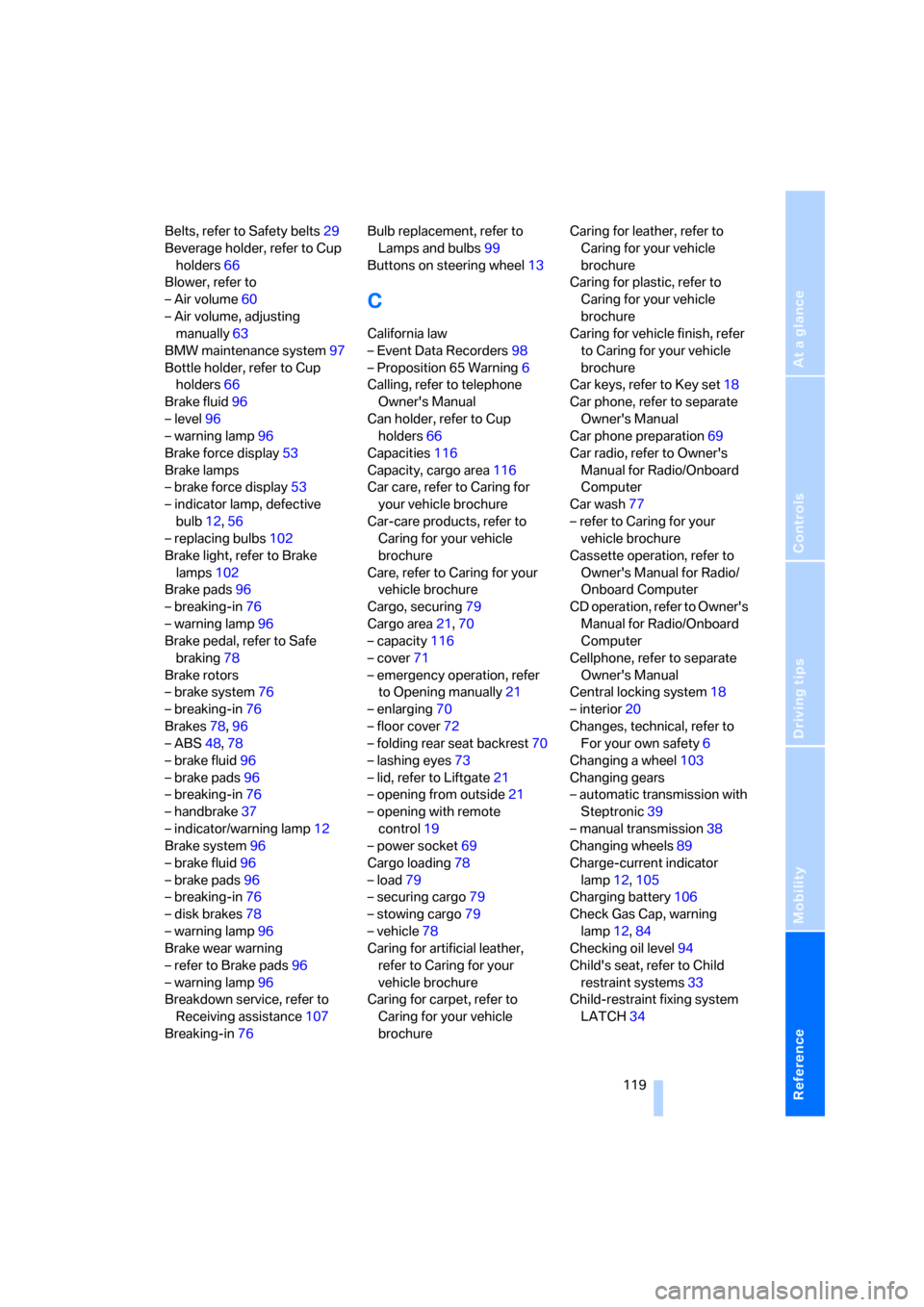
Reference
At a glance
Controls
Driving tips
Mobility
119
Belts, refer to Safety belts29
Beverage holder, refer to Cup
holders66
Blower, refer to
– Air volume60
– Air volume, adjusting
manually63
BMW maintenance system97
Bottle holder, refer to Cup
holders66
Brake fluid96
– level96
– warning lamp96
Brake force display53
Brake lamps
– brake force display53
– indicator lamp, defective
bulb12,56
– replacing bulbs102
Brake light, refer to Brake
lamps102
Brake pads96
– breaking-in76
– warning lamp96
Brake pedal, refer to Safe
braking78
Brake rotors
– brake system76
– breaking-in76
Brakes78,96
– ABS48,78
– brake fluid96
– brake pads96
– breaking-in76
– handbrake37
– indicator/warning lamp12
Brake system96
– brake fluid96
– brake pads96
– breaking-in76
– disk brakes78
– warning lamp96
Brake wear warning
– refer to Brake pads96
– warning lamp96
Breakdown service, refer to
Receiving assistance107
Breaking-in76Bulb replacement, refer to
Lamps and bulbs99
Buttons on steering wheel13
C
California law
– Event Data Recorders98
– Proposition 65 Warning6
Calling, refer to telephone
Owner's Manual
Can holder, refer to Cup
holders66
Capacities116
Capacity, cargo area116
Car care, refer to Caring for
your vehicle brochure
Car-care products, refer to
Caring for your vehicle
brochure
Care, refer to Caring for your
vehicle brochure
Cargo, securing79
Cargo area21,70
– capacity116
– cover71
– emergency operation, refer
to Opening manually21
– enlarging70
– floor cover72
– folding rear seat backrest70
– lashing eyes73
– lid, refer to Liftgate21
– opening from outside21
– opening with remote
control19
– power socket69
Cargo loading78
– load79
– securing cargo79
– stowing cargo79
– vehicle78
Caring for artificial leather,
refer to Caring for your
vehicle brochure
Caring for carpet, refer to
Caring for your vehicle
brochureCaring for leather, refer to
Caring for your vehicle
brochure
Caring for plastic, refer to
Caring for your vehicle
brochure
Caring for vehicle finish, refer
to Caring for your vehicle
brochure
Car keys, refer to Key set18
Car phone, refer to separate
Owner's Manual
Car phone preparation69
Car radio, refer to Owner's
Manual for Radio/Onboard
Computer
Car wash77
– refer to Caring for your
vehicle brochure
Cassette operation, refer to
Owner's Manual for Radio/
Onboard Computer
CD operation, refer to Owner's
Manual for Radio/Onboard
Computer
Cellphone, refer to separate
Owner's Manual
Central locking system18
– interior20
Changes, technical, refer to
For your own safety6
Changing a wheel103
Changing gears
– automatic transmission with
Steptronic39
– manual transmission38
Changing wheels89
Charge-current indicator
lamp12,105
Charging battery106
Check Gas Cap, warning
lamp12,84
Checking oil level94
Child's seat, refer to Child
restraint systems33
Child-restraint fixing system
LATCH34
Page 122 of 133
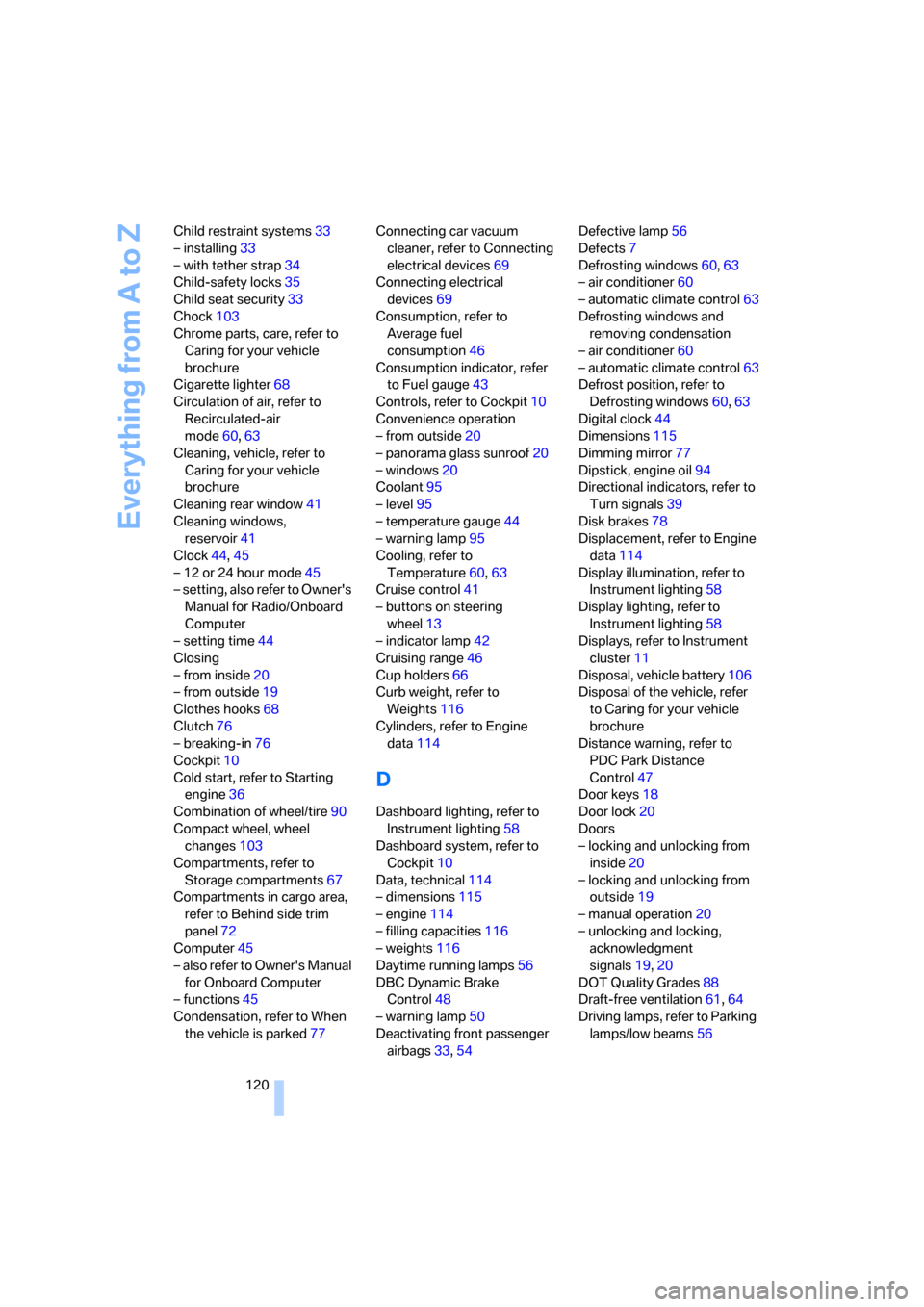
Everything from A to Z
120 Child restraint systems33
– installing33
– with tether strap34
Child-safety locks35
Child seat security33
Chock103
Chrome parts, care, refer to
Caring for your vehicle
brochure
Cigarette lighter68
Circulation of air, refer to
Recirculated-air
mode60,63
Cleaning, vehicle, refer to
Caring for your vehicle
brochure
Cleaning rear window41
Cleaning windows,
reservoir41
Clock44,45
– 12 or 24 hour mode45
– setting, also refer to Owner's
Manual for Radio/Onboard
Computer
– setting time44
Closing
– from inside20
– from outside19
Clothes hooks68
Clutch76
– breaking-in76
Cockpit10
Cold start, refer to Starting
engine36
Combination of wheel/tire90
Compact wheel, wheel
changes103
Compartments, refer to
Storage compartments67
Compartments in cargo area,
refer to Behind side trim
panel72
Computer45
– also refer to Owner's Manual
for Onboard Computer
– functions45
Condensation, refer to When
the vehicle is parked77Connecting car vacuum
cleaner, refer to Connecting
electrical devices69
Connecting electrical
devices69
Consumption, refer to
Average fuel
consumption46
Consumption indicator, refer
to Fuel gauge43
Controls, refer to Cockpit10
Convenience operation
– from outside20
– panorama glass sunroof20
– windows20
Coolant95
– level
95
– temperature gauge44
– warning lamp95
Cooling, refer to
Temperature60,63
Cruise control41
– buttons on steering
wheel13
– indicator lamp42
Cruising range46
Cup holders66
Curb weight, refer to
Weights116
Cylinders, refer to Engine
data114
D
Dashboard lighting, refer to
Instrument lighting58
Dashboard system, refer to
Cockpit10
Data, technical114
– dimensions115
– engine114
– filling capacities116
– weights116
Daytime running lamps56
DBC Dynamic Brake
Control48
– warning lamp50
Deactivating front passenger
airbags33,54Defective lamp56
Defects7
Defrosting windows60,63
– air conditioner60
– automatic climate control63
Defrosting windows and
removing condensation
– air conditioner60
– automatic climate control63
Defrost position, refer to
Defrosting windows60,63
Digital clock44
Dimensions115
Dimming mirror77
Dipstick, engine oil94
Directional indicators, refer to
Turn signals39
Disk brakes78
Displacement, refer to Engine
data114
Display illumination, refer to
Instrument lighting58
Display lighting, refer to
Instrument lighting58
Displays, refer to Instrument
cluster11
Disposal, vehicle battery106
Disposal of the vehicle, refer
to Caring for your vehicle
brochure
Distance warning, refer to
PDC Park Distance
Control47
Door keys18
Door lock20
Doors
– locking and unlocking from
inside20
– locking and unlocking from
outside19
– manual operation20
– unlocking and locking,
acknowledgment
signals19,
20
DOT Quality Grades88
Draft-free ventilation61,64
Driving lamps, refer to Parking
lamps/low beams56
Page 124 of 133

Everything from A to Z
122 Fuel filler door84
– releasing in the event of
electrical malfunction84
Fuel gauge43
Fuel tank contents, refer to
Filling capacities116
Full preparation package
mobile phone, refer to
separate Owner's Manual
Fuses106
G
Garage-door opener, refer to
Integrated universal remote
control65
Gasoline
– refer to Average
consumption46
– refer to Fuel quality85
– refer to Fuel
specifications85
Gasoline display, refer to Fuel
gauge43
Gear indicator with automatic
transmission with
Steptronic38
Gearshift lever, manual
transmission38
General driving notes76
Glove compartment67
Grills, refer to
Ventilation61,64
Gross vehicle weight, refer to
Weights116
Ground clearance80
H
Halogen lamps100
Handbrake37
– indicator lamp37
Hands-free microphone, refer
to Car phone preparation69
Hazard warning flashers10
HDC Hill Descent Control49
Head airbags53
Headlamp control,
automatic56Headlamp flasher39
– indicator lamp12
Headlamps100
– care, refer to Caring for your
vehicle brochure
– replacing bulbs99
Headlamp washer
reservoir41
– capacity, refer to Filling
capacities116
Headlamp washer system
– headlamp washing41
– washer fluid41
Head Light, refer to Adaptive
Head Light57
Head restraints28
– installing, front28
– removing, front28
– sitting safely26
Heated mirrors31
Heated rear window
– air conditioner60
– automatic climate control64
Heated seats29
Heated steering wheel31
Heater
– rear window60,64
– windshield washer jets41
Heating
– exterior mirror31
– seats29
– steering wheel31
Heating and ventilation59,62
Heavy cargo, refer to Cargo
loading78
Height, refer to
Dimensions115
Height adjustment
– seats27
– steering wheel31
High beams57
– headlight flasher57
– indicator lamp12
– replacing bulbs101
High Performance Synthetic
Oil95
Hill-climbing ability, refer to
Driving on poor roads80Hill descent assistance, refer
to HDC Hill Descent
Control49
Hill Descent Control HDC49
Hills78
Holder for beverages66
Hood92
Horn10
Hotel function18
Hot exhaust system77
Hydraulic Brake Assistant,
refer to DBC Dynamic Brake
Control48
Hydroplaning77
I
Icy conditions, refer to
Outside temperature
warning45
Ignition36
Ignition key18
Ignition key positions, refer to
Ignition lock36
Ignition lock36
Indicator/warning lamp
– airbags54
– alarm system25
– automatic transmission with
Steptronic39
– brakes96
– coolant temperature44
– DSC48
– engine temperature44
– Flat Tire Monitor51
– fog lamps57
– front passenger airbags54
– overview12
– reserve43
– safety belt warning30
– Tire Pressure Monitor52
Indicator and warning
lamps12
Individual settings, refer to
Vehicle Memory,
Key Memory32
Inflation pressure, refer to Tire
inflation pressure86